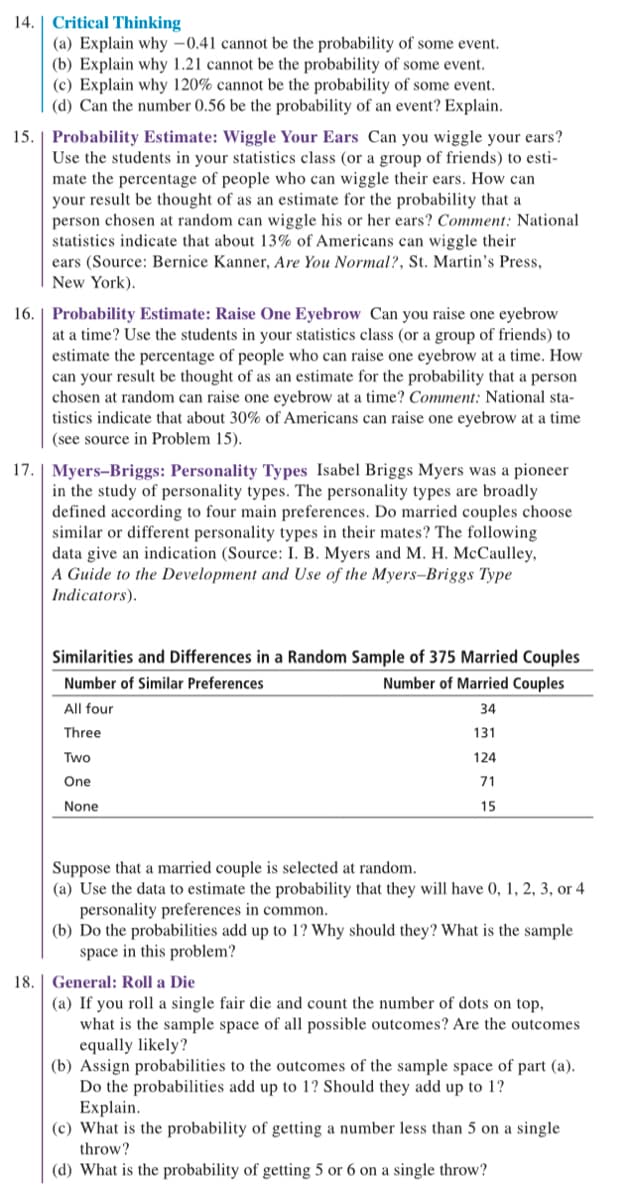Critical Thinking (a) Explain why -0.41 cannot be the probability of some event. (b) Explain why 1.21 cannot be the probability of some event. (c) Explain why 120% cannot be the probability of some event. (d) Can the number 0.56 be the probability of an event? Explain.
Critical Thinking (a) Explain why -0.41 cannot be the probability of some event. (b) Explain why 1.21 cannot be the probability of some event. (c) Explain why 120% cannot be the probability of some event. (d) Can the number 0.56 be the probability of an event? Explain.
Holt Mcdougal Larson Pre-algebra: Student Edition 2012
1st Edition
ISBN:9780547587776
Author:HOLT MCDOUGAL
Publisher:HOLT MCDOUGAL
Chapter6: Ratio, Proportion, And Probability
Section6.7: Probability And Odds
Problem 10E
Related questions
Question
Please answer number 14. All parts to the question!

Transcribed Image Text:14. Critical Thinking
(a) Explain why -0.41 cannot be the probability of some event.
(b) Explain why 1.21 cannot be the probability of some event.
(c) Explain why 120% cannot be the probability of some event.
(d) Can the number 0.56 be the probability of an event? Explain.
15. Probability Estimate: Wiggle Your Ears Can you wiggle your ears?
Use the students in your statistics class (or a group of friends) to esti-
mate the percentage of people who can wiggle their ears. How can
your result be thought of as an estimate for the probability that a
person chosen at random can wiggle his or her ears? Comment: National
statistics indicate that about 13% of Americans can wiggle their
ears (Source: Bernice Kanner, Are You Normal?, St. Martin's Press,
New York).
16. Probability Estimate: Raise One Eyebrow Can you raise one eyebrow
at a time? Use the students in your statistics class (or a group of friends) to
estimate the percentage of people who can raise one eyebrow at a time. How
can your result be thought of as an estimate for the probability that a person
chosen at random can raise one eyebrow at a time? Comment: National sta-
tistics indicate that about 30% of Americans can raise one eyebrow at a time
(see source in Problem 15).
17. | Myers-Briggs: Personality Types Isabel Briggs Myers was a pioneer
in the study of personality types. The personality types are broadly
defined according to four main preferences. Do married couples choose
similar or different personality types in their mates? The following
data give an indication (Source: I. B. Myers and M. H. McCaulley,
A Guide to the Development and Use of the Myers-Briggs Type
Indicators).
Similarities and Differences in a Random Sample of 375 Married Couples
Number of Similar Preferences
Number of Married Couples
All four
34
Three
131
Two
One
None
124
71
15
Suppose that a married couple is selected at random.
(a) Use the data to estimate the probability that they will have 0, 1, 2, 3, or 4
personality preferences in common.
(b) Do the probabilities add up to 1? Why should they? What is the sample
space in this problem?
18. General: Roll a Die
(a) If you roll a single fair die and count the number of dots on top,
what is the sample space of all possible outcomes? Are the outcomes
equally likely?
(b) Assign probabilities to the outcomes of the sample space of part (a).
Do the probabilities add up to 1? Should they add up to 1?
Explain.
(c) What is the probability of getting a number less than 5 on a single
throw?
(d) What is the probability of getting 5 or 6 on a single throw?
Expert Solution
This question has been solved!
Explore an expertly crafted, step-by-step solution for a thorough understanding of key concepts.
This is a popular solution!
Trending now
This is a popular solution!
Step by step
Solved in 3 steps

Recommended textbooks for you

Holt Mcdougal Larson Pre-algebra: Student Edition…
Algebra
ISBN:
9780547587776
Author:
HOLT MCDOUGAL
Publisher:
HOLT MCDOUGAL

College Algebra
Algebra
ISBN:
9781305115545
Author:
James Stewart, Lothar Redlin, Saleem Watson
Publisher:
Cengage Learning

College Algebra (MindTap Course List)
Algebra
ISBN:
9781305652231
Author:
R. David Gustafson, Jeff Hughes
Publisher:
Cengage Learning

Holt Mcdougal Larson Pre-algebra: Student Edition…
Algebra
ISBN:
9780547587776
Author:
HOLT MCDOUGAL
Publisher:
HOLT MCDOUGAL

College Algebra
Algebra
ISBN:
9781305115545
Author:
James Stewart, Lothar Redlin, Saleem Watson
Publisher:
Cengage Learning

College Algebra (MindTap Course List)
Algebra
ISBN:
9781305652231
Author:
R. David Gustafson, Jeff Hughes
Publisher:
Cengage Learning